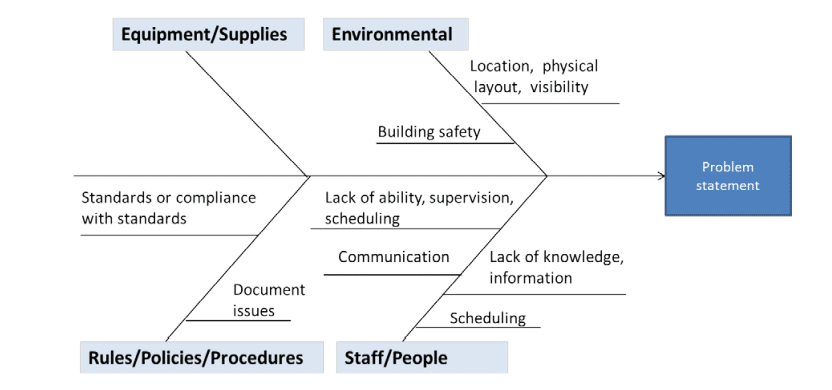The course of business never did run smooth. Things can – and will – go wrong. As a business, we need to learn from our mistakes and adapt.
But when fixing problems, it’s often not enough to put a plaster over it. Sometimes it’s necessary to get to the very heart of the matter, which may not be immediately obvious. But fixing problems at their root cause is more likely to prove a longer-term fix and stop them occurring again.
Here we’ll look at root cause analysis, and how putting it into practice could be of real benefit to your business.
Key points:
- Identifying the root cause of a problem is the best way to ensure that an issue doesn’t recur in future.
- Root cause analysis involves a team identifying and defining a problem, then working backwards to unearth its root cause or causes. One of the most common techniques is to use a fishbone diagram, where categories contributing to the problem are identified, and each category is traced to its root.
- This exercise is easy to understand and apply and is frequently used in conjunction with the ‘five whys’ technique. However, its suitability diminishes as problems grow more complex.
What is root cause analysis?
Root cause analysis is a technique employed to identify the primary causes of problems, rather than simply addressing their symptoms. In tracing a problem’s symptoms to its origin, implementing a fix should stop the issue recurring further down the line.
Typically, there will be three basic types of root cause:
- Physical causes: A tangible item or object, which has usually failed in some regard: eg a printer has jammed.
- Human causes: A problem was caused in some way by a person or people. This may well lead to a physical problem: eg somebody loaded paper into a printer incorrectly, causing it to jam.
- Organisational causes: A process, system or policy within an organisation is faulty, giving rise to issues: eg inadequate training was given on how to operate the printer, meaning someone loaded paper into it incorrectly, causing it to jam.
How to approach root cause analysis
In order to identify potential root causes to a problem, it helps to visualise the situation. One common technique is the use of a fishbone diagram (AKA Ishikawa diagram or cause-and-effect diagram). This allows you to chart relatively complex problems, by thinking about and categorising all the factors that may have led to an issue.

Fishbone diagram example (cms.gov)
Here, the problem or effect is represented by the head of the fish. In attempting to find the root causes of the problem, you work backwards and flesh out the fish’s bones.
Visualising the problem in this way helps to clearly show the relationship between cause and effect, which is intended to be useful in identifying likely causes.
What steps do you need to take for root cause analysis?
To perform the analysis, you gather your team. If the problem affects several teams, then gather a group of staff with knowledge of the problem from each relevant team. The objective is to brainstorm the problem and identify root causes.
#Step 1: Define the problem
To make sure everybody understands what the problem you wish to remedy is, the best starting point is to define it in clear, concise terms. When stating the problem, it tends to form a question.
For example:
- General: Why did the website crash?
- In sales: Why did the customer complain?
- In manufacturing: Why has the robot stopped working?
When visualising the problem, if you’re using a fishbone diagram, this question is written in its head.
The most important objective of this step is to define the problem and identify its scope. It may be necessary to collect data at this stage, to help with the analysis, and clarify just how big a problem it really is.
#Step 2: Define your categories
Next, you define the categories which will help guide your analysis.
Certain industries tend to have common categories. For example, in manufacturing, the categories may be defined as 5 M’s:
1. Manpower
2. Machines
3. Materials
4. Methods
5. Measurements.
It’s important to note that the categories don’t have to be set in stone. If further discussion reveals additional categories down the line, it’s perfectly acceptable to update the diagram accordingly. Likewise, if any are revealed to be red herrings, it’s OK to remove them.
#Step 3: Identify root causes
For each category, you should identify top-level causes for each category. But the aim isn’t to stop there, but rather drill down until you’ve identified the root cause for each.
An exercise you could apply for surfacing root causes is the five whys technique. We talk in detail about the five whys technique here. But in essence, this entails asking ‘why?’ of causes until you can’t ask it any further and have therefore identified the root. The number five here is a rule of thumb, but it may take more or fewer ‘why?’ questions to get to the heart of the matter.
#Step 4: Address the root cause(s) and implement solutions
Once identified, the root causes can be tackled. The next stage of the exercise is to agree solutions or countermeasures to be put into place. This should hopefully stop the problem from occurring again.
#Step 5: Monitor and assess your measures
Once solutions are put in place, you should monitor and assess their effectiveness. If the correct root causes have been addressed, the problem should cease. However, if the problem continues, or isn’t eliminated entirely, it may be that the correct root cause wasn’t identified, and you may need to repeat the exercise.
What are the advantages and disadvantages of root cause analysis?
Advantages
One of the obvious advantages of this technique is that it’s simple to understand, and easy to implement. It can also be applied to a range of different problems, across any type of industry.
While it can be used in conjunction with the five whys technique, it’s better for more complex problems, as it allows for more than one root cause. While the five whys technique is a type of root cause analysis, it should only be used for simple problems likely to have just one identifiable root cause.
Plus, this approach can have several benefits for your staff. At a basic level, it should help them to gain a better understanding of the problem at hand. But perhaps more importantly, it can help to boost their confidence, as it will give them more faith in their problem-solving abilities. And it should hopefully also empower them to tackle the root causes of issues in future.
Disadvantages
While being a useful technique, root cause analysis isn’t perfect. It becomes less useful given more complex problems. For example, you may identify multiple causes, it doesn’t necessarily help you to prioritise them. In addition, with more and more categories and potential root causes, the diagram can become unwieldy.
If you need to help hone your team’s problem-solving abilities, feel free to get in touch.







